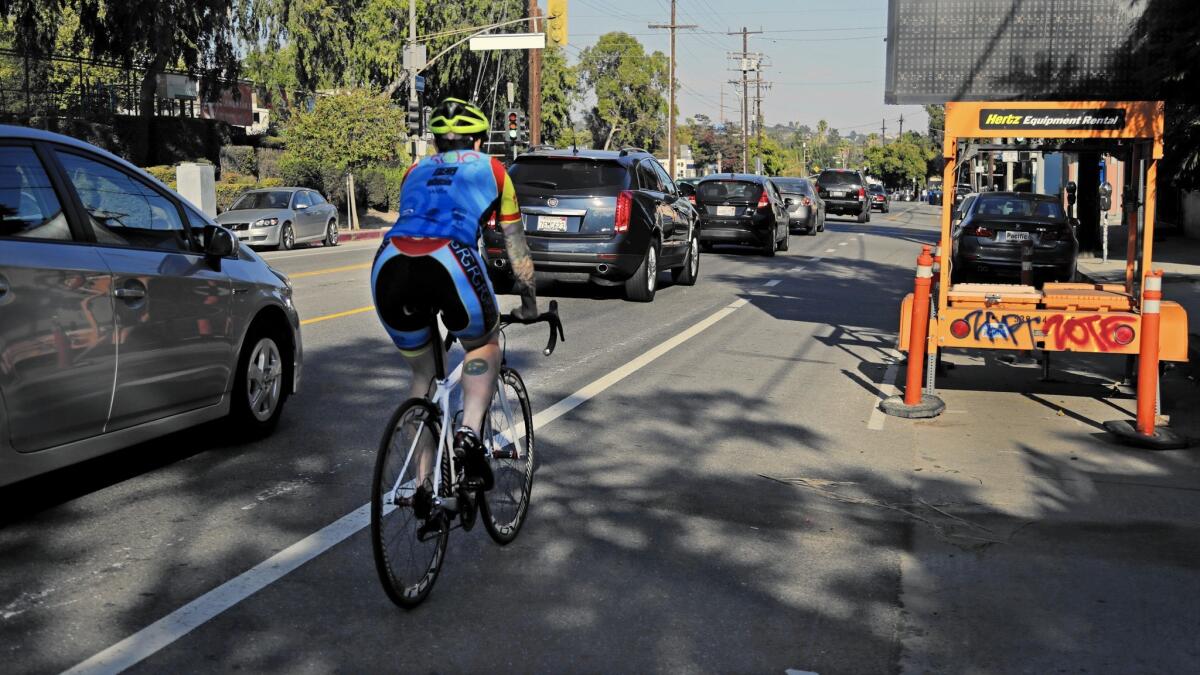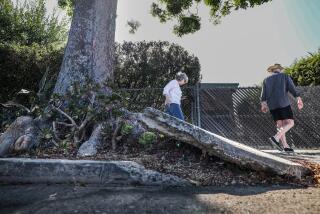Silver Lake street serves as test run for L.A. traffic overhaul

- Share via
Three years ago, Silver Lake residents were horrified by a traffic collision that claimed the life of a 24-year-old woman celebrating her birthday with her dad.
Ashley Sandau had emerged from a restaurant late one night and was crossing Rowena Avenue toward her father, who was waiting on the other side. As he watched, she was struck by a car and killed.
In the wake of that tragedy, then-City Councilman Tom LaBonge moved to make the street safer by slowing traffic. He backed a decision to put Rowena on a so-called road diet, reducing it from four vehicle lanes to two, and adding bicycle lanes on each side.
City officials say the reduction led to tangible results: seven crashes during an eight-month period of 2013, compared with 15 in 2008. But residents contend there were also unintended consequences: major traffic backups during rush hour that have sent cars darting onto quieter side streets.
The added congestion, they say, has prompted impatient drivers to take detours, sometimes driving too fast or rolling through stop signs. “The danger on Rowena got shifted to the surrounding streets, and that is the biggest problem,” said Jerome Courshon, an independent film producer who lives north of Rowena.
The Silver Lake project has emerged as a controversial symbol of the tradeoffs city officials will face over the next two decades as they try to slow traffic, reduce collision rates and give the public an expanded menu of transportation options.
Mobility Plan 2035, a sweeping transportation policy approved by the City Council last week, seeks to shift the city’s emphasis away from the automobile. It looks to add hundreds of miles of bicycle and bus-only lanes — changes that could make an array of boulevards across the city resemble Rowena.
The plan also calls for policymakers to reduce traffic fatalities to zero within 20 years by designing roads in ways that keep traffic within the speed limit. But an environmental review of the plan also warned of significant consequences, including an increase in cut-through traffic on residential streets and a doubling in the number of highly congested major street segments.
Council members have already added dozens of miles of bike routes, some of them accompanied by reductions in car lanes. Yet as they have expanded that citywide bike network, they have not looked to determine whether the number of backups on those corridors grew significantly as a result. In cases where road diets were examined, officials focused mainly on the number of collisions and the number of people using the bike lanes — not the effect on traffic congestion.
City officials say they intend to examine traffic patterns in the future.
“We need to build a really solid, big portfolio of data on projects like these all around the city so people can see in real time what the pros and cons will be,” said Seleta Reynolds, general manager of the Department of Transportation, adding: “In the absence of data, anecdotes rule. We have to have good data there to dispel rumors on either side.”
Rowena is one of the first corridors to come under the microscope. And so far, officials say, they are seeing fewer and less-severe crashes.
The avenue, which runs east-west in the area southeast of Griffith Park, is a major conduit between Los Feliz and Echo Park. The half-mile section of Rowena that was included in the road diet is dotted with boutiques, hair salons and restaurants, as well as Ivanhoe Elementary School. Crosswalks are scarce on that stretch.
After the road diet was put in place, city officials found that the average speed for 85% of drivers on the avenue had declined. Average speeds of those who traveled west decreased by 3 mph, down from 39 mph to 36 mph. Eastbound average travel speeds were lowered to 35 mph — the legal limit for that corridor, according to Department of Transportation spokesman Bruce Gillman.
The department obtained its speed data on a single Monday between 11:30 a.m. and noon. Future reviews will also be conducted during the same time period to ensure the agency has apples-to-apples comparisons, Gillman said.
Reducing a vehicle’s speed by a few miles per hour can significantly reduce the risk of severe injury for pedestrians and cyclists, experts say. Pedestrians face a 25% chance of severe injury if they are hit by a car driving 23 mph, according to studies performed for the AAA Foundation for Traffic Safety. When the car is going 39 mph, the risk rises to 75%.
Police say the car that hit Sandau on March 30, 2012, was traveling 35 mph. Her father contends the speed was closer to 50 mph. The car had a shattered windshield and a 12-inch dent in the hood, he said.
On the night of her death, Sandau and her father had gone to dinner in Silver Lake. She was planning to take a new job on the East Coast, and they drove afterward to Edendale Grill on Rowena so she could say goodbye to some friends, family members said.
As her father waited in the car, Sandau left the restaurant and crossed Rowena. A vehicle in the first westbound lane stopped for her. The one in the second westbound lane struck her.
By that time, city officials had already designated a half-mile stretch of Rowena as a “backbone” street for its network of bike lanes. But after Sandau’s death, the push to add those lanes — and reduce the amount of space for cars — gained serious momentum.
LaBonge said the tragedy helped prompt him to redesign Rowena between Hyperion Avenue on the west and Glendale Boulevard on the east. The changes included the creation of a center turn lane as a buffer. “I felt it was important to try something that may make it safer,” he said.
Critics of the changes say city officials did not prepare for what happened next.
Silver Lake resident Betsy Isroelit, who lives south of Rowena, said her hillside street experienced significant spillover traffic from drivers trying to find east-west shortcuts. Unable to pass on a narrow road built in the 1920s, drivers coming from opposite directions have found themselves at loggerheads, the freelance writer said.
During one incident, two motorists climbed out of their cars and started yelling at each other, Isroelit said. During another, a neighbor had to go into the street to direct cars herself.
“Everybody wants there to be more mobility and more opportunities to walk and bike and take subways and buses,” she said. “But I think the city officials also have to look at reality — and the consequences of what’s going to happen when these changes are made.”
Isroelit said she thinks traffic problems have subsided somewhat during the summer months, with school out of session and drivers avoiding a construction project at the nearby Silver Lake Reservoir. Meanwhile, one of her neighbors says the added inconvenience has been worth it.
Jennie Chamberlain, 42, said her neighbors have reported some clipped fenders and banged up mirrors as a result of cut-through traffic. But she also worries less about the safety of her twins, both fifth-graders at Ivanhoe Elementary, located right on Rowena.
Before the arrival of the road diet, she said, it was “kind of terrifying” to watch them cross Rowena on their way to school, wondering if a speeding driver would run a red light. With four lanes, Rowena would simply attract even more cars, Chamberlain added.
“If we’re going to get the traffic either way, I’d rather live in the neighborhood with the narrower, safer street,” she said.
By May, complaints over traffic on Rowena had spilled into the debate about another Silver Lake public works project: reconstruction of the nearby Hyperion Avenue bridge. Pedestrian and bicycle groups sought to have the number of car lanes on the span reduced from four to three, freeing up more room for bike lanes and sidewalks.
The Board of Public Works rejected that idea, with one member citing what he saw as serious traffic problems on Rowena. Then-board member Matt Szabo, an appointee of Mayor Eric Garcetti, said the Rowena lane restriping had been “a bit of a disaster,” producing major backups south of the Hyperion bridge.
“I can’t in good conscience vote for anything that would compound that situation,” he said at the time.
Backers of the Rowena bike lanes made a push two months later to get the Silver Lake Neighborhood Council to formally endorse them. The neighborhood council tabled that motion two weeks ago after receiving nearly three dozen complaint e-mails. Instead, the group scheduled a town hall for next month to gather more comments on the project.
The city’s new mobility plan calls for even more changes to Silver Lake streets. Hyperion Avenue, which intersects with Rowena, would get dedicated bike lanes, as would nearby Riverside Drive. A stretch of Glendale Boulevard would receive “protected bike lanes” — the kind separated from traffic by curbs and other physical barriers.
LaBonge, the former councilman, voiced doubts about those proposals, saying they would seriously affect the flow of traffic. But he argued that the Rowena road diet is doing what it was supposed to do.
“There hasn’t been a fatality on that street since the road diet came in,” he said.
Liz Harte, Sandau’s mother, thinks city leaders should keep Rowena’s lanes as they are. Having only two car lanes, she said, would ensure that drivers proceed as a more cautious pace.
“My daughter would want that,” said the retired school teacher who lives in upstate New York. “I think she would want the safety of other people. I don’t want her death to be in vain.”
ALSO:
Three killed when two planes collide near San Diego’s Brown Field
In-custody death of man accused of stealing U.S. flag investigated
Silver Lake street serves as a test run for L.A.’s traffic overhaul
More to Read
Sign up for Essential California
The most important California stories and recommendations in your inbox every morning.
You may occasionally receive promotional content from the Los Angeles Times.















